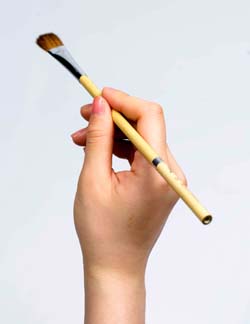Art and Art Making Can be Toxic
To Your Health and the Environment
by Wendy Priesnitz
 Ever since primitive hunters created cave drawings tens of thousands of years ago, artists have used their work to understand Nature. Whether they are painting the landscapes of New Mexico like Georgia O’Keefe, drawing political cartoons like Richard Wilson, publicizing hemp by driving around in a biogas bus like actor Woody Harrelson or writing about ecological disaster like John Wyndham, artists influence the way we see the natural world. Since they are used to experimenting with and transcending the status quo, artists have an important role in provoking environmental and social change. Ever since primitive hunters created cave drawings tens of thousands of years ago, artists have used their work to understand Nature. Whether they are painting the landscapes of New Mexico like Georgia O’Keefe, drawing political cartoons like Richard Wilson, publicizing hemp by driving around in a biogas bus like actor Woody Harrelson or writing about ecological disaster like John Wyndham, artists influence the way we see the natural world. Since they are used to experimenting with and transcending the status quo, artists have an important role in provoking environmental and social change.
As Huey Johnson, founder of the Resource Renewal Institute, has said, “The urgency and importance of the message to restore health to the environment needs to be carried in every possible form of media and communication and art is one of the most powerful languages humans have ever invented.”
Unfortunately, many of the activities engaged in by artists are, in themselves, a danger to the environment, not to mention the health of the artists and those they are seeking to influence. Artists use many of the same hazardous chemicals found in industry, often without adequate precautions and ventilation.
Dusts, powders, vapors, gases and aerosols are easily inhaled. For instance, lung damage can result from silica or asbestos present in dry earth clays. Organ damage can occur following inhalation of solvent vapors and subsequent absorption into the bloodstream.
Ingestion of hazardous substances can also occur through oral contact with hands or tools used in art projects. This route of exposure is an important concern with children, with their tendency to put things in their mouths.
Lastly, skin contact with hazardous materials may result in local or internal effects. Caustic substances or solvents can cause local skin damage. Certain solvents can also pass through the skin into the bloodstream, resulting in damage to other organs.
Exposure to toxic materials may result in either acute or chronic illness. An acute illness may result from a relatively large exposure over a short period of time. An example would be the intoxication-like symptoms following inadvertent ingestion of toxic solvents. A chronic illness may result from small exposures over a long period of time, as in degeneration of the nervous system from exposure to products containing lead.
| Artists use many of the same hazardous chemicals found in industry, often without adequate precautions and ventilation. |
Young people who are still growing are especially vulnerable, because they have a more rapid metabolism than adults and are more likely to absorb toxic materials into their bodies. They have smaller lungs and lower body weight, predisposing them to more risks. Also, they cannot be depended upon to understand the need to carry out precautions.
So whether you are an artist, educator or parent, check labels, refer to Material Safety Data Sheets and create good studio management habits. And where possible, only purchase some of the 60,000 or so art and craft materials certified by the Art & Creative Materials Institute. All products in this program undergo extensive toxicological testing before they are granted the use of certification seals.
In 1793 the painter Francisco de Goya contracted what is thought to have been lead poisoning, which left him deaf and crippled. In 1970 the sculptor Eva Hesse died of cancer, probably caused by her use of fiberglass. With the growing awareness of these hazards, artists can protect their own health and that of the environment, while helping their audiences to understand and protect the natural world.
Learn More
Searching for Safer Art & Craft Materials by Robyn Coburn in Natural Life Magazine
The Artist’s Complete Health and Safety Guide by Monona Rossol (Allworth Press, 2001)
Health Hazards Manual for Artists by Michael McCann (Lyons and Burford, 1994)
Wendy Priesnitz is the Editor of Natural Life Magazine and a journalist with over 40 years of experience. She used to be a stained glass artist (until she got sick from breathing the soldering fumes), and has also authored 13 books.
|

